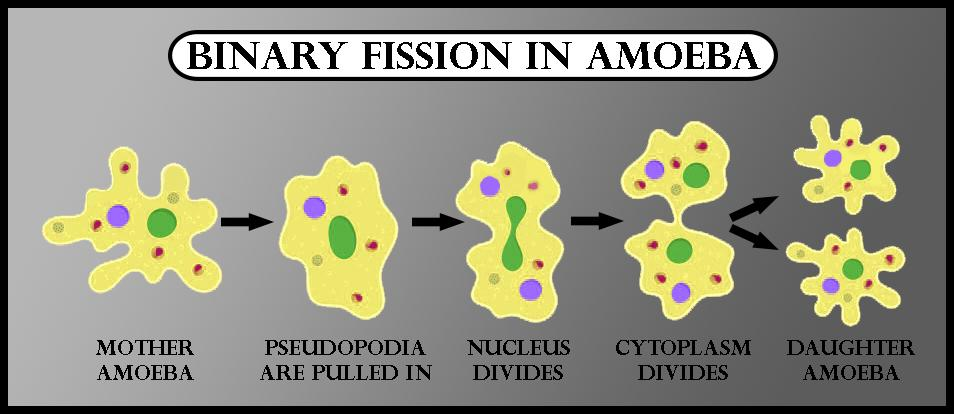
How do prokaryotes reproduce?
Answer
525.6k+ views
Hint: Prokaryotes are small, unicellular organisms that do not have membrane-bound organelles. Prokaryotes are bacteria and blue-green algae. The reproduction that occurs may be of both sexual and asexual type depending upon certain organisms.
Complete answer:
Prokaryotic cells are generally smaller and multiply faster than the eukaryotic cells. Prokaryotic cells are those cells that are not enclosed in a membrane or an envelope. Reproduction in the case of prokaryotes maybe both sexual and asexual depending upon organisms and their mechanism. In the case of bacteria and archaea, sexual reproduction occurs by transferring the DNA. Sexual reproduction in bacteria occurs in three stages that include, first stage is the bacterial virus-mediated transduction, the second stage is plasmid-mediated conjugation, and the third stage is the natural transformation. Here the the DNA is transferred to the recipient cell with the help of a sex pilus which is the simply the extension of the plasm membrane.
While the asexual reproduction generally involves the presence of a single parent and the resulting offspring is devoid of any kind of mutation and hence remains genetically identical to the parent. Some of the methods by which asexual reproduction results in offsprings are fragmentation, budding, and fission. Binary fission and multiple fission are the two types of fission. Binary fission is the process where the two new daughter cells are produced by the division of the single parent cell while multiple fission is a mode of reproduction in which the single-parent cell is divided into many daughter cells. Both the methods result in the formation of new daughter cells or organisms which are identical to the parents. When the parent organism tends to break into fragments and each of the fragments results in a new organism this process is known as fragmentation and is a process of asexual reproduction.

Note:
There are generally two ways through which the Living beings reproduce to produce their offspring that is sexual reproduction and asexual reproduction. When the fusion of the gametes of two parents occurs that result in the formation of offsprings then it is known as sexual reproduction while in asexual reproduction only one parent is involved in producing offspring. Asexual reproduction is of various types including fragmentation, budding, spore formation, fission, and vegetative propagation.
Complete answer:
Prokaryotic cells are generally smaller and multiply faster than the eukaryotic cells. Prokaryotic cells are those cells that are not enclosed in a membrane or an envelope. Reproduction in the case of prokaryotes maybe both sexual and asexual depending upon organisms and their mechanism. In the case of bacteria and archaea, sexual reproduction occurs by transferring the DNA. Sexual reproduction in bacteria occurs in three stages that include, first stage is the bacterial virus-mediated transduction, the second stage is plasmid-mediated conjugation, and the third stage is the natural transformation. Here the the DNA is transferred to the recipient cell with the help of a sex pilus which is the simply the extension of the plasm membrane.
While the asexual reproduction generally involves the presence of a single parent and the resulting offspring is devoid of any kind of mutation and hence remains genetically identical to the parent. Some of the methods by which asexual reproduction results in offsprings are fragmentation, budding, and fission. Binary fission and multiple fission are the two types of fission. Binary fission is the process where the two new daughter cells are produced by the division of the single parent cell while multiple fission is a mode of reproduction in which the single-parent cell is divided into many daughter cells. Both the methods result in the formation of new daughter cells or organisms which are identical to the parents. When the parent organism tends to break into fragments and each of the fragments results in a new organism this process is known as fragmentation and is a process of asexual reproduction.

Note:
There are generally two ways through which the Living beings reproduce to produce their offspring that is sexual reproduction and asexual reproduction. When the fusion of the gametes of two parents occurs that result in the formation of offsprings then it is known as sexual reproduction while in asexual reproduction only one parent is involved in producing offspring. Asexual reproduction is of various types including fragmentation, budding, spore formation, fission, and vegetative propagation.
Recently Updated Pages
Master Class 10 General Knowledge: Engaging Questions & Answers for Success

Master Class 10 Science: Engaging Questions & Answers for Success

Master Class 10 Social Science: Engaging Questions & Answers for Success

Master Class 10 Maths: Engaging Questions & Answers for Success

Master Class 10 English: Engaging Questions & Answers for Success

Master Class 10 Computer Science: Engaging Questions & Answers for Success

Trending doubts
Which places in India experience sunrise first and class 9 social science CBSE

Fill the blanks with the suitable prepositions 1 The class 9 english CBSE

Write the 6 fundamental rights of India and explain in detail

Difference Between Plant Cell and Animal Cell

What is the Full Form of ISI and RAW

Golden Revolution is related to AFood production BOil class 9 social science CBSE




